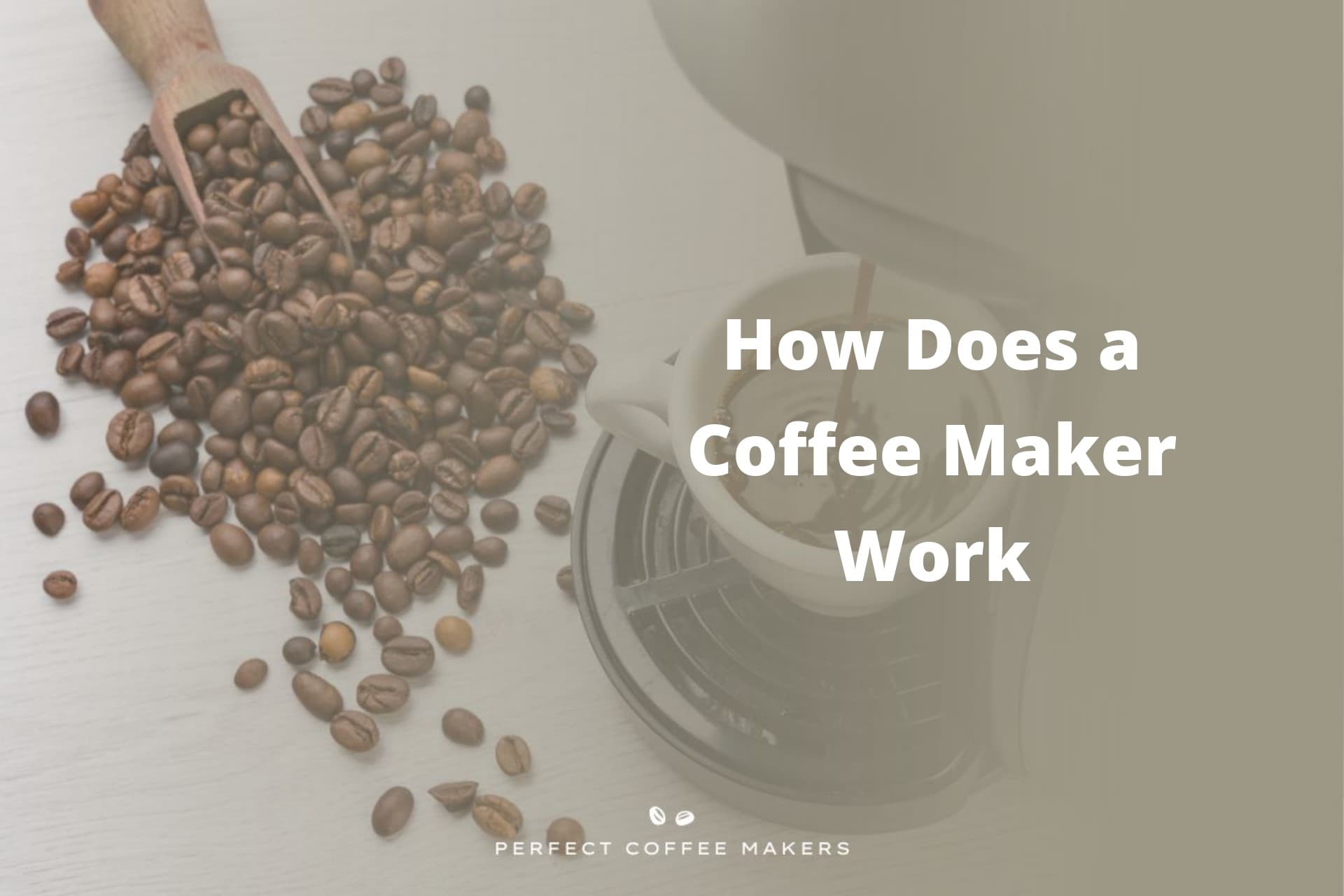Owning a coffee maker is a joy for many, but have you ever stopped to ponder the science behind that consistently perfect brew? It’s quite fascinating how this everyday appliance transforms simple water and coffee grounds into your favorite morning elixir. Let’s take a moment to understand the inner workings of a coffee maker.
A typical drip coffee maker works through a simple yet effective process. When you add water to the reservoir and switch on the machine, it heats the water near boiling point. This heated water rises up a tube and drips onto the coffee grounds placed in a filter. The hot water then extracts the flavors from the coffee grounds as it passes through them, ending up in a pot placed underneath, giving you a freshly brewed cup of coffee.
Components and Mechanisms of a Coffee Maker
Coffee makers, whether it’s a drip coffee maker or a percolator, consist of several essential components including a machine, heating element, water tube, and keurig that work together to brew that perfect cup of joe. Understanding how filter coffee machines and drip coffee machines function can help demystify the process behind your morning pick-me-up. These machines use a tube and heating element to brew your coffee.
Water Reservoir and Heating Element
At the heart of every Keurig coffee machine lies the water reservoir and heating element. The water reservoir in drip coffee machines holds the cold water that will be transformed into hot liquid by the heating element, making it ready for brewing in filter coffee machines. Connected to the reservoir in coffee machines is a heating chamber containing a resistive heating element for filter coffee machine.
When you power on your coffee machine, this heating element springs into action. The heating element in the machine rapidly heats up, reaching ideal temperatures for brewing coffee. As the water warms within the coffee machine’s reservoir, the heating element gradually raises its temperature until it reaches the sweet spot where extraction occurs.
Pump or Gravity System
Once the water, heated by the heating element, has reached the desired temperature, it needs to make its way from the reservoir to where it meets the coffee grounds in the machine. This is where either a coffee machine pump or gravity system comes into play to heat the water using the heating element.
In some drip coffee makers, a pump assists the machine in moving the heated water through an aluminum tube and into a shower head above the filter basket, where it is then distributed. This process is made possible by the heating element that warms the water. The coffee machine’s shower head evenly distributes hot water from the heating element over the grounds for optimal extraction.
On the other hand, simpler drip coffee makers may rely on gravity alone to move water from the reservoir down into a faucet-like opening located above the filter basket. These machines use gravity and do not require any heating mechanism. The force of gravity allows for consistent flow as hot water from the coffee machine drips onto your waiting grounds, heating them up.
Filter Basket and Carafe
The filter basket in your coffee machine serves as home to your precious ground coffee beans during brewing, ensuring optimal heating. The coffee machine filter has a twofold purpose: first, it prevents larger particles from entering your carafe; secondly, it allows the brewed liquid to pass through while trapping the flavorful oils and sediments, ensuring a delicious cup of coffee. The heating element inside the coffee machine helps to maintain the optimal temperature for brewing.
Drip coffee makers, a popular machine for brewing coffee, often utilize paper filters to aid in the filtration process. These filters are placed inside the baskets of the coffee maker to ensure optimal heating and extraction of flavors. These disposable filters catch the coffee grounds in the machine, making cleanup after brewing a hot cup of coffee a breeze. Additionally, they help maintain the heating system of the machine by preventing any clogs or damage caused by the grounds. However, some machines come equipped with permanent metal filters that can be rinsed and reused.
Once the coffee machine brewing process is complete, the liquid gold drips down into the carafe below. The carafe acts as a container for your freshly brewed coffee, keeping it warm until you’re ready to pour yourself a cup. This machine is designed to maintain the temperature of your coffee for optimal enjoyment.
Additional Components and Features
While the aforementioned machine parts are central to any coffee maker’s operation, various additional machine components and features can enhance your brewing experience. These may include:
- Sensors: Some advanced coffee machines have sensors that monitor water levels, temperature, and even brew strength.
- Many drip coffee makers feature a warming plate beneath the carafe to keep the machine warm. This keeps your brewed coffee hot for extended periods.
- 3-Way Valve: Espresso machines often utilize a 3-way valve to regulate pressure during extraction.
- Control Panel: Modern coffee makers may boast digital control panels with programmable settings for convenience. These control panels allow users to easily operate the machine and customize their coffee experience.
Understanding how these components work together in harmony allows you to appreciate the complexity behind every cup of joe brewed by your trusted machine. So next time you take that first sip of deliciousness from your coffee machine, remember all the parts working diligently behind the scenes to make it happen!
Step-by-Step Guide to Using a Coffee Maker
Fill the water reservoir with cold, clean water up to the desired level.
To start brewing your perfect cup of coffee, the first step is to fill the water reservoir of your coffee machine. Make sure you use cold and clean water in your coffee machine for the best results. The water reservoir is usually located at the back or side of the machine and can be easily accessed. Check the markings on the coffee machine reservoir to ensure you add enough water for your desired number of cups.
Add coffee grounds to the filter basket according to your preferred strength.
Once you have filled the water reservoir of your coffee machine, it’s time to add coffee grounds to the machine. Most coffee makers, including the machine, come with a filter basket where you place a paper filter or a reusable metal filter. This is where you’ll add your ground coffee beans. The amount of coffee grounds you use in your machine will depend on how strong you prefer your brew. As a general guideline, use one tablespoon of ground coffee per six ounces of water for a standard cup in a coffee machine.
Place an empty carafe or cup on the warming plate or beneath the dispenser spout.
Before starting the brewing process, make sure there is an empty carafe or cup in place to collect your freshly brewed coffee from the machine. The carafe usually sits on a warming plate that keeps your brewed coffee hot until you’re ready to enjoy it with your machine. Alternatively, if your coffee machine has a dispenser spout, position an empty cup beneath it to catch every drop of deliciousness.
Press start or activate the brew button to begin brewing.
Now that the coffee machine is set up, it’s time to start brewing! Look for either a start button or brew button on your coffee machine and press it to initiate the brewing process. Some advanced coffee machine models may have additional options like programmable timers or strength settings that allow you to customize your brew further. Experiment with these features once you become more familiar with using your specific machine.
Congratulations! You’ve successfully learned the basic steps to operate a coffee machine maker. By following these simple instructions, you’ll be able to enjoy a freshly brewed cup of coffee from your machine whenever you desire. So go ahead, set up your coffee machine, and savor the aroma and taste of your favorite brew.
Brewing Process: From Bean to Brew
The brewing process of a coffee maker is a fascinating journey that transforms simple coffee beans into a delicious cup of joe. Let’s dive into the step-by-step process and uncover the magic behind how your favorite morning pick-me-up, made using a coffee machine, comes to life.
Hot Water Meets Ground Coffee Beans
The brewing process commences when boiling water flows through the coffee grounds in the filter basket. As the water passes over the finely ground coffee beans in the coffee machine, it extracts soluble compounds from them, including oils, flavors, and aromatic substances. This interaction between water and coffee is what gives brewed coffee its distinct taste and aroma.
The Extraction Process Unfolds
As the hot water flows through the coffee machine’s filter basket, it gradually absorbs the essence of the ground beans. The extraction process in a coffee machine occurs due to two primary factors: temperature and time. The boiling water releases heat that breaks down complex compounds within the coffee grounds, allowing them to dissolve easily into the liquid.
Moreover, as gravity pulls water downward through a tube or spout, it ensures that every particle of ground coffee is thoroughly saturated and extracted. This meticulous flow guarantees an even distribution of flavors throughout your brew, using a high-quality coffee machine.
Bid Farewell to Used Grounds
Once all the desirable components have been extracted from the coffee grounds, they are left behind in the filter while only brewed coffee continues its journey towards your awaiting cup or carafe. This separation allows you to savor a smooth cup of coffee from your coffee machine without any unwanted residue or grit.
Keeping It Warm on a Hot Plate
To ensure that your freshly brewed concoction remains at an optimal temperature for consumption, many coffee makers feature a hot plate beneath the carafe or cup holder. This hot plate provides gentle heat to keep your coffee machine warm without scorching or altering its flavor profile.
A Steady Supply with Water Tanks
Coffee makers often come equipped with built-in water tanks designed to hold an adequate amount of water for brewing. These tanks are easily refillable, allowing you to enjoy multiple cups of coffee without the need for constant refilling.
The Perfect Cup, Ready to Savor
And there you have it! From the moment hot water meets ground coffee beans in the filter basket to the final pour into your cup, the coffee maker’s brewing process works its magic. The coffee machine combines heat, extraction, and careful filtration to deliver a delightful and aromatic beverage that kickstarts your day on a flavorful note.
So next time you take a sip of that freshly brewed cup of joe from your coffee machine, remember the intricate journey those humble coffee beans embarked upon to bring you this moment of caffeinated bliss.
Understanding Different Types of Coffee Machines
Drip Brewers: Simplicity and Ease of Use
Drip coffee machines, also known as filter coffee machines, are a popular choice for many coffee enthusiasts due to their simplicity and ease of use. These machines are perfect for everyday home brewing, allowing you to enjoy a fresh cup of joe without any hassle.
With a drip coffee machine, the process is straightforward. First, you fill the water reservoir with cold water. Then, you add your desired amount of ground coffee to a paper or metal filter. The machine then heats the water and pours it over the coffee grounds in the filter. As the hot water passes through the coffee machine, it extracts all those delicious flavors and oils before dripping down into a carafe or mug.
Drip brewers offer flexibility. You can adjust factors such as grind size and coffee-to-water ratio to achieve your preferred taste profile. Some advanced models come with programmable timers, allowing you to wake up to freshly brewed coffee in the morning.
Espresso Machines: Harnessing Pressure for Bold Flavors
If you’re looking for a more intense caffeine kick or enjoy sipping on rich espresso shots, an espresso machine might be your go-to option. These machines utilize pressure and finely ground beans to produce concentrated shots of espresso that form the base of various beloved coffee beverages like lattes and cappuccinos.
Espresso machines work by forcing hot water through tightly packed fine coffee grounds under high pressure. This coffee machine process extracts flavors rapidly while creating that characteristic layer of crema on top of each shot. Some espresso machines have built-in grinders so that you can grind your beans fresh before brewing.
There are two main types of espresso machines: manual (lever-operated) and automatic (pump-driven). Manual machines require skillful hand-operating techniques to control extraction time and pressure manually. On the other hand, automatic machines handle the brewing process for you at the touch of a button, making them more convenient for those who prefer consistency and ease.
Single-Cup Pod Machines: Convenience in a Snap
For those seeking ultimate convenience and minimal cleanup, single-cup pod machines have become increasingly popular. These machines use pre-packaged pods that contain measured amounts of coffee. All you need to do is insert the pod into the machine, press a button, and voila! Your coffee will be ready in no time.
Single-cup pod machines offer a wide variety of flavors and beverage options. Whether you crave a classic black coffee or prefer indulging in flavored brews like caramel macchiatos or hazelnut lattes, there’s a pod out there to suit your taste buds.
These machines are ideal for individuals with busy lifestyles or households with varying coffee preferences. Each person can choose their preferred flavor without any cross-contamination between cups. Moreover, cleaning up is as easy as discarding the used pod and rinsing out the machine.
Troubleshooting and Maintenance Tips for Coffee Makers
Cleaning Clogged Filters
One common issue that coffee makers often face is clogged filters. When the filter becomes blocked, it can result in slow brewing or even a complete halt to the coffee-making process. To fix this problem, you can easily clean the filters by following a few simple steps:
- Remove the filter from your coffee maker.
- Rinse it under warm water to remove any loose debris.
- Fill a bowl with warm soapy water and soak the filter for several minutes.
- Gently scrub the filter using a soft brush or sponge to dislodge any stubborn residue.
- Rinse the filter thoroughly to ensure all soap residue is removed.
- Allow the filter to air dry completely before placing it back into your coffee maker.
Regularly cleaning your filters in this manner will help prevent clogs and ensure optimal performance from your coffee maker.
Descaling Your Coffee Maker
Over time, mineral deposits can build up inside your coffee maker, affecting its overall performance and taste of brewed coffee. Descaling is an essential maintenance step that helps remove these deposits and keeps your machine running smoothly.
To descale your coffee maker:
- Mix equal parts of white vinegar and water in the water reservoir.
- Place an empty carafe beneath the brew basket to collect the solution as it cycles through.
- Start a brew cycle without adding any coffee grounds.
- Allow half of the vinegar-water mixture to run through, then pause the cycle for about 30 minutes.
- Resume brewing until all of the solution has passed through.
Remember to follow manufacturer instructions regarding descaling methods specific to your machine, as some models may require different procedures.
Exterior Cleaning Tips
Maintaining cleanliness on both the inside and outside of your coffee maker is crucial for its longevity and appearance. When cleaning its exterior:
- Use a damp cloth to wipe down the surfaces, removing any fingerprints or spills.
- Avoid using abrasive cleaners that may damage the finish of your coffee maker.
By regularly cleaning and maintaining your coffee maker’s exterior, you can keep it looking as good as new for years to come.
Exploring Specialty Coffee Brewing Methods
French Press Brewing Method
French press brewing is a popular method that involves steeping coffee grounds in hot water before pressing them down with a plunger. This method allows for maximum extraction of flavors and oils from the coffee beans, resulting in a rich and full-bodied cup of coffee.
To brew coffee using a French press, start by heating water to the desired temperature. Coarsely grind the coffee beans and add them to the bottom of the French press. Pour hot water over the grounds, ensuring that all of them are saturated. Let the coffee steep for about four minutes, allowing the flavors to fully develop.
Once the steeping time is complete, slowly press down on the plunger, separating the brewed coffee from the grounds. The metal mesh filter in the French press ensures that no sediment or fine particles make their way into your cup. Pour out your freshly brewed coffee and savor its robust flavor profile.
French press brewing offers flexibility in terms of adjusting brew strength by varying factors such as grind size, water temperature, and steeping time. It’s an excellent choice for those who appreciate bold flavors and enjoy experimenting with different variables to achieve their desired taste.
Pour-Over Brewing Method
Pour-over brewing is a meticulous process that involves pouring hot water over a filter containing coffee grounds for precise extraction. This method allows for greater control over factors such as water flow rate and saturation level, resulting in a clean and well-balanced cup of coffee.
To brew using this method, you’ll need a pour-over device (such as a V60 or Chemex), filter paper, freshly ground coffee beans, and hot water just off boiling point. Begin by placing the filter paper inside the pour-over device and rinsing it with hot water to remove any papery taste.
Next, add your desired amount of ground coffee into the filter-lined pour-over device. Start pouring hot water in a slow, controlled manner, ensuring that all the grounds are evenly saturated. The water should be poured in circular motions, allowing for even extraction.
As the coffee drips through the filter into your cup, take note of the aroma and color changes. Adjust your pouring technique accordingly to achieve the desired strength and flavor profile. Once all the water has passed through the filter, remove it from the device and enjoy your meticulously brewed pour-over coffee.
Pour-over brewing is favored by coffee enthusiasts who appreciate the ritualistic aspect of making coffee and value precision in their brewing process. It allows for customization based on personal preferences and offers a clean and nuanced taste experience.
Cold Brew Method
Cold brew is a popular alternative to traditional hot brewing methods. It involves steeping coffee grounds in cold water for an extended period, usually overnight or up to 24 hours. This slow extraction process results in a smooth and less acidic brew with subtle flavors.
To make cold brew at home, coarsely grind your preferred coffee beans and add them to a jar or container. Pour cold water over the grounds until they are fully submerged. Stir gently to ensure even saturation, then cover and let it steep in the refrigerator for at least 12 hours.
After steeping, strain the mixture using a fine-mesh sieve or cheesecloth to separate the liquid from the grounds. The resulting concentrate can be diluted with water or milk according to taste preferences.
Mastering the Art of Coffee Making
Congratulations! You’ve now mastered the art of coffee making. From understanding the components and mechanisms of a coffee maker to learning the step-by-step guide and brewing process, you’re well-equipped to brew a perfect cup of joe every time. But don’t stop here – there’s still more to explore in the world of coffee!
To continue your journey, why not delve into the realm of specialty coffee brewing methods? Experiment with pour-over, French press, or even try your hand at espresso-making. The possibilities are endless, and each method offers a unique flavor profile that will elevate your coffee experience.
So go ahead, grab your favorite beans, fire up that trusty coffee maker, and start brewing like a pro. Remember to always have fun along the way and savor every sip. Happy brewing!
FAQs
How often should I clean my coffee maker?
It is recommended to clean your coffee maker at least once a month to ensure optimal performance and prevent any buildup of mineral deposits or oils that can affect the taste of your brew. However, if you use your machine frequently or notice any changes in taste or quality, it’s best to clean it more often.
Can I use regular ground coffee in an espresso machine?
While it’s possible to use regular ground coffee in an espresso machine, it may not produce the same results as using finely ground espresso beans. Regular ground coffee is coarser and may result in a weaker or less flavorful shot of espresso. For best results, invest in a good-quality espresso grind specifically designed for espresso machines.
How do I descale my coffee maker?
Descaling helps remove mineral deposits that can accumulate over time and affect the performance of your coffee maker. To descale your machine, mix equal parts white vinegar and water and run it through a brew cycle. Then run plain water through several cycles to rinse out any remaining vinegar taste.
Can I make iced coffee with a regular coffee maker?
Absolutely! To make iced coffee, brew your coffee using your regular coffee maker and let it cool. Once cooled, pour the brewed coffee over ice and add any desired sweeteners or milk. You can also experiment with cold brew methods for a smoother, less acidic iced coffee experience.
How long should I let my coffee steep in a French press?
For a French press, the recommended steeping time is around 4-5 minutes. However, you can adjust this based on personal preference. If you prefer a stronger cup of coffee, you can extend the steeping time by a minute or two. Experimentation is key to finding your perfect brew strength!




